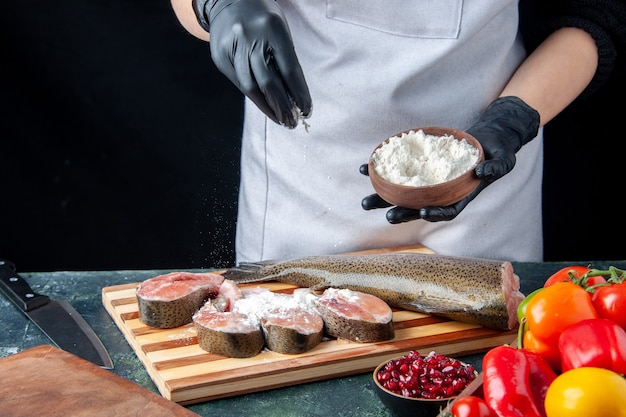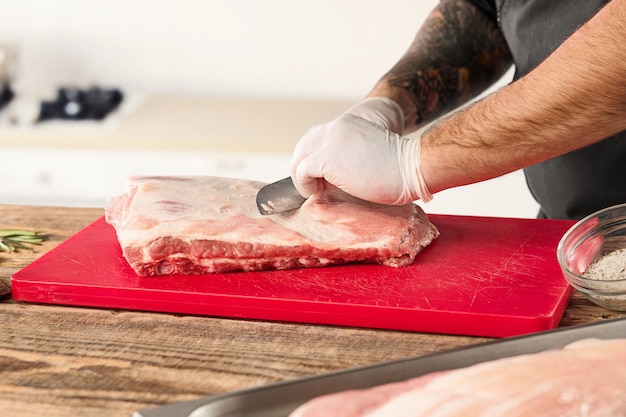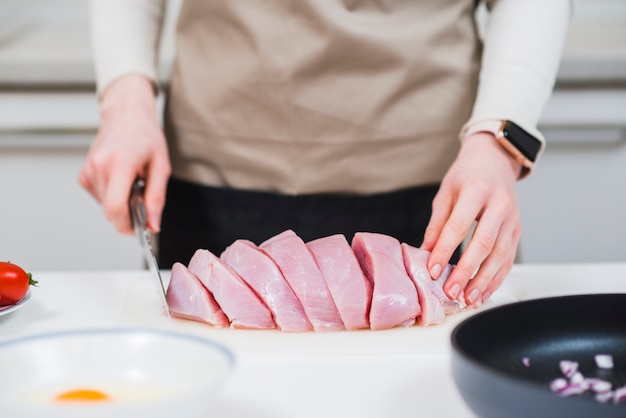Let's face it, pig feet. Not everyone's first choice, right? But trust me, there's a whole world of flavour waiting to be unlocked in these humble hooves. I've been cooking with pig feet for years, and I'm here to share my secrets, from choosing the perfect pig feet to perfecting that melt-in-your-mouth texture. Get ready to ditch any preconceptions, grab your aprons, and embark on a culinary journey that will redefine your understanding of pig feet.
(Part 1) The Pig Feet – Choosing, Cleaning, and Prepping

The Perfect Pig Feet – What to Look For
The first step is finding the right pig feet, and a good butcher or a Chinese supermarket is usually your best bet. Look for pig feet that are plump, firm, and have a nice, even colour. Avoid any that look discolored or have an unpleasant smell. You want to start with the best quality possible for the best flavour.
Hair Today, Gone Tomorrow – Removing the Hair
Now, those pig feet are still sporting a bit of hair, so let's get rid of it. There are two main methods:
The Blowtorch Method: This is a quick and efficient option, but it requires a bit of caution. Use a blowtorch to singe the hair off, but be extremely careful not to set the pig feet on fire!
The Gas Flame Method: This is the traditional method, involving scorching the pig feet over a gas flame. Ensure you work in a well-ventilated area, and watch out for any flare-ups.
Once the hair is singed, use a sharp knife to scrape it off, leaving you with clean and ready-to-cook pig feet.
Prepping for Perfection – The Final Touches
Now that the hair is gone, it's time to give those pig feet a good scrub under cold running water with a stiff brush. Remove any lingering dirt or debris. Once they're sparkling clean, trim the hooves and any excess fat. You can also cut the pig feet into smaller pieces for easier handling, depending on your recipe.
(Part 2) The Art of Cooking – Transforming Pig Feet into Deliciousness

pressure cooker – A Quick and Easy Option
This is my go-to method for cooking pig feet, and it's a lifesaver for busy cooks. Just pop the pig feet into your pressure cooker with enough water to cover them. Add some salt, pepper, and your favourite seasonings. Close the lid, turn on the heat, and let it reach high pressure. Cook for 45-60 minutes, or until the meat is fork-tender. The pressure cooker does the hard work, making the meat melt in your mouth.
slow cooker – Hands-Off, Delicious Results
For those days when you need a hands-off approach, the slow cooker is your best friend. Place the pig feet in your slow cooker, cover them with water, and add your favourite seasonings. Set it to low for 6-8 hours, or until the meat is falling off the bone. The slow cooker magic makes the meat unbelievably tender and infused with flavour.
oven method – For a Deeper, More Complex Flavour
This method is a bit more involved but worth the effort if you're looking for a deeper, more complex flavour. Preheat your oven to 300°F (150°C). Spread the pig feet in a single layer in a baking dish. Add some water to the bottom of the dish, cover it with foil, and bake for 2-3 hours, or until the meat is tender.
(Part 3) Flavour Bombs – Exploring the World of Pig Feet Sauces

The Classic – Chinese Style
This sauce is a must-try for any pig feet enthusiast. It's a beautiful blend of sweet, salty, and tangy flavours that perfectly complement the richness of the meat. The key ingredients are soy sauce, rice vinegar, sugar, and ginger, with an optional pinch of red pepper flakes for a touch of spice.
To make it, simply combine 1/2 cup of soy sauce, 1/4 cup of rice vinegar, 2 tablespoons of sugar, and 1 tablespoon of grated ginger. The sauce should be a balanced blend, but you can adjust the ingredients to suit your taste.
The Adventurous – Caribbean Jerk Style
If you're looking for a more adventurous flavour profile, try the Caribbean jerk style sauce. This bold sauce packs a punch with its fiery scotch bonnet peppers, allspice, thyme, garlic, and onion. It's a mix of smoky, spicy, and herbaceous flavours that will make your taste buds sing.
To create this delicious sauce, combine 1/4 cup of chopped scotch bonnet peppers, 1 tablespoon of allspice, 1 tablespoon of thyme, 2 cloves of garlic, and 1/2 of a medium onion. Adjust the amount of scotch bonnet peppers based on your spice tolerance.
The Bold – Spicy Korean Style
For a truly unique flavour experience, go for the Korean style sauce. It's a complex blend of sweet, spicy, and umami flavours, thanks to the gochujang (Korean chili paste) that takes centre stage. This sauce also includes soy sauce, garlic, ginger, and sugar to balance out the heat and add depth of flavour.
To make this sauce, mix together 1/4 cup of gochujang, 1/4 cup of soy sauce, 2 cloves of garlic, 1 tablespoon of grated ginger, and 1 tablespoon of sugar. A splash of sesame oil adds a lovely aroma and richness.
(Part 4) Mastering the Meat – Serving Suggestions
The Classic – With Rice
There's a reason why pig feet are often served with rice. The tender meat and rich sauce pair perfectly with the fluffy grains, creating a comforting and satisfying meal. Add a side of stir-fried vegetables for a balanced and healthy dish.
The Creative – With Noodles
Shake things up and try serving your pig feet with noodles. The sauce will coat the noodles beautifully, and the combination of textures is a real treat. You can use any type of noodles you like – ramen, udon, or even spaghetti.
The Modern – With Salad
For a lighter and refreshing option, pair your pig feet with a fresh salad. The crisp vegetables will cut through the richness of the meat, creating a balanced and delightful meal. You can even add a drizzle of the pig feet sauce to the salad for an extra layer of flavour.
(Part 5) The Ultimate Guide to Eating Pig Feet – Etiquette and Enjoyment
Respecting the Bone – Navigating the Feast
Eating pig feet is a bit of an adventure, so let's do it with grace and respect. First, you need to separate the meat from the bone. Use your fingers to pull the meat off the bone or use a fork to gently separate it. No shame in using your fingers – it's often the best way to get the most flavour!
Navigating the Skin – A Matter of Taste
Pig feet have a thick, gelatinous skin. Some love it, some don't. If you're not a fan, simply give it a good tug, and it should come off easily. But if you're feeling adventurous, keep the skin on! It adds a wonderful texture and flavour to the dish.
Enjoying Every Bite – Savoring the Experience
With your perfectly prepared pig feet, take a deep breath, relax, and enjoy! The meat should be unbelievably tender and melt in your mouth. Savour the flavour of the sauce, the unique texture of the pig feet, and the satisfying feeling of conquering a new culinary challenge.
(Part 6) The Nutritional Value – Pig Feet Power
A Protein Powerhouse – More Than Just a Treat
Pig feet are surprisingly packed with protein, providing a good source of this essential nutrient. They also contain several important vitamins and minerals, including iron, zinc, and vitamin B12. So, if you're looking for a protein-rich meal that's full of flavour, pig feet should definitely be on your list.
Collagen Boost – For Skin, Bones, and Joints
Pig feet are a fantastic source of collagen, a protein that plays a crucial role in maintaining healthy skin, bones, and joints. Collagen is also beneficial for hair and nails. So, if you're looking for a natural way to boost your collagen intake, pig feet are an excellent choice.
A Word of Caution – Saturated Fat
While pig feet are a great source of protein and collagen, they are also high in saturated fat. So, like all things, moderation is key. Enjoy pig feet as part of a balanced diet, and be mindful of your overall fat intake.
(Part 7) The Cultural Significance – Pig Feet Around the Globe
A Global Delicacy – A Taste of the World
Pig feet are a popular dish in many cultures around the world. In the Caribbean, they're often stewed with spices and served with rice and beans. In the Philippines, they're braised with soy sauce and vinegar and served with pickled vegetables. In China, they're stir-fried with garlic, ginger, and chili peppers. This global appreciation speaks to the versatility and deliciousness of this humble cut of meat.
A History of Flavour – Centuries of Culinary Tradition
The popularity of pig feet dates back centuries, often rooted in the need to utilize all parts of the animal and avoid waste. Today, pig feet are celebrated for their unique texture and flavour and are a staple in many cuisines worldwide.
(Part 8) The Future of Pig Feet – A Culinary Trend on the Rise
From Humble Beginnings to High-End Cuisine – A New Appreciation
In recent years, pig feet have experienced a surge in popularity. They're no longer just a humble dish but are increasingly featured on the menus of upscale restaurants. Chefs are embracing the unique texture and flavour, incorporating pig feet into everything from soups and stews to tacos and salads. The culinary world is rediscovering the deliciousness of pig feet.
The Rise of the Food Trend – A Global Phenomenon
The growing popularity of pig feet is due to several factors: they're a delicious and affordable source of protein, their unique texture and flavour are attracting adventurous eaters, and the growing trend of utilizing all parts of the animal is driving demand for this once overlooked cut of meat. Pig feet are experiencing a global culinary renaissance.
(Part 9) The FAQs – Getting Answers
Are pig feet safe to eat?
Yes, pig feet are perfectly safe to eat when cooked thoroughly. Ensure you cook them until the meat is tender and pulls easily from the bone, reaching an internal temperature of at least 165°F (74°C).
How do I know if pig feet are cooked properly?
The meat should be incredibly tender and easily pull away from the bone. It should also be cooked through and have an internal temperature of at least 165°F (74°C).
What can I do with leftover pig feet?
Leftover pig feet can be stored in the fridge for up to 3 days. Reheat them in the oven or microwave. They can also be used in other dishes, such as stews, soups, or salads.
Can you freeze pig feet?
Yes, you can freeze pig feet. Simply place them in a freezer-safe bag and freeze for up to 3 months. When ready to use, thaw them in the refrigerator overnight.
What are some other cuts of meat that are similar to pig feet?
Other cuts of meat that share a similar texture and flavour include pig ears, pig tails, and chicken feet.
There you have it! Now you're equipped to conquer the world of pig feet. Get out there, experiment, and have fun with it. It's a culinary adventure you won't want to miss! Happy cooking!
Everyone is watching

Corn on the Cob: The Ultimate Guide to Perfectly Cooked Ears
Healthy MealsAh, corn on the cob. Just the name evokes images of sunny days, barbecues, and that sweet, juicy flavour that ...

Perfect Pork Roast Oven Cooking Time: A Guide to Delicious Results
Healthy MealsThere's something truly satisfying about a perfectly roasted pork. The aroma alone is enough to make your mout...

Scallops: The Ultimate Guide to Perfect Cooking
Healthy MealsAh, scallops. Those delicate, sweet, and utterly delicious morsels of the sea. They hold a special place in my...

Ham Cooking Time: How Long to Bake, Smoke, or Boil a Delicious Ham
Healthy MealsAh, ham. It's a classic, isn't it? A real crowd-pleaser, especially around holidays. And when done right, it'...

Spaghetti Squash: The Ultimate Guide to Cooking and Serving
Healthy MealsRemember that time you saw spaghetti squash at the supermarket, looking all bumpy and strange, and thought, "W...
